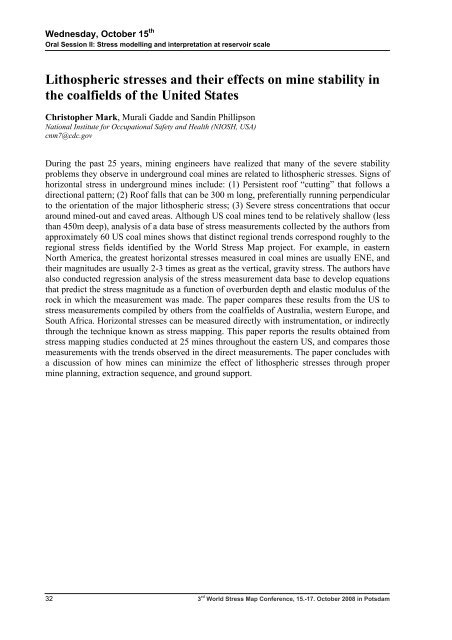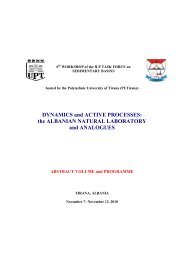World Stress Map Conference - International Lithosphere Program ...
World Stress Map Conference - International Lithosphere Program ...
World Stress Map Conference - International Lithosphere Program ...
You also want an ePaper? Increase the reach of your titles
YUMPU automatically turns print PDFs into web optimized ePapers that Google loves.
Wednesday, October 15 th<br />
Oral Session II: <strong>Stress</strong> modelling and interpretation at reservoir scale<br />
Lithospheric stresses and their effects on mine stability in<br />
the coalfields of the United States<br />
Christopher Mark, Murali Gadde and Sandin Phillipson<br />
National Institute for Occupational Safety and Health (NIOSH, USA)<br />
cnm7@cdc.gov<br />
During the past 25 years, mining engineers have realized that many of the severe stability<br />
problems they observe in underground coal mines are related to lithospheric stresses. Signs of<br />
horizontal stress in underground mines include: (1) Persistent roof “cutting” that follows a<br />
directional pattern; (2) Roof falls that can be 300 m long, preferentially running perpendicular<br />
to the orientation of the major lithospheric stress; (3) Severe stress concentrations that occur<br />
around mined-out and caved areas. Although US coal mines tend to be relatively shallow (less<br />
than 450m deep), analysis of a data base of stress measurements collected by the authors from<br />
approximately 60 US coal mines shows that distinct regional trends correspond roughly to the<br />
regional stress fields identified by the <strong>World</strong> <strong>Stress</strong> <strong>Map</strong> project. For example, in eastern<br />
North America, the greatest horizontal stresses measured in coal mines are usually ENE, and<br />
their magnitudes are usually 2-3 times as great as the vertical, gravity stress. The authors have<br />
also conducted regression analysis of the stress measurement data base to develop equations<br />
that predict the stress magnitude as a function of overburden depth and elastic modulus of the<br />
rock in which the measurement was made. The paper compares these results from the US to<br />
stress measurements compiled by others from the coalfields of Australia, western Europe, and<br />
South Africa. Horizontal stresses can be measured directly with instrumentation, or indirectly<br />
through the technique known as stress mapping. This paper reports the results obtained from<br />
stress mapping studies conducted at 25 mines throughout the eastern US, and compares those<br />
measurements with the trends observed in the direct measurements. The paper concludes with<br />
a discussion of how mines can minimize the effect of lithospheric stresses through proper<br />
mine planning, extraction sequence, and ground support.<br />
32 3 rd <strong>World</strong> <strong>Stress</strong> <strong>Map</strong> <strong>Conference</strong>, 15.-17. October 2008 in Potsdam




